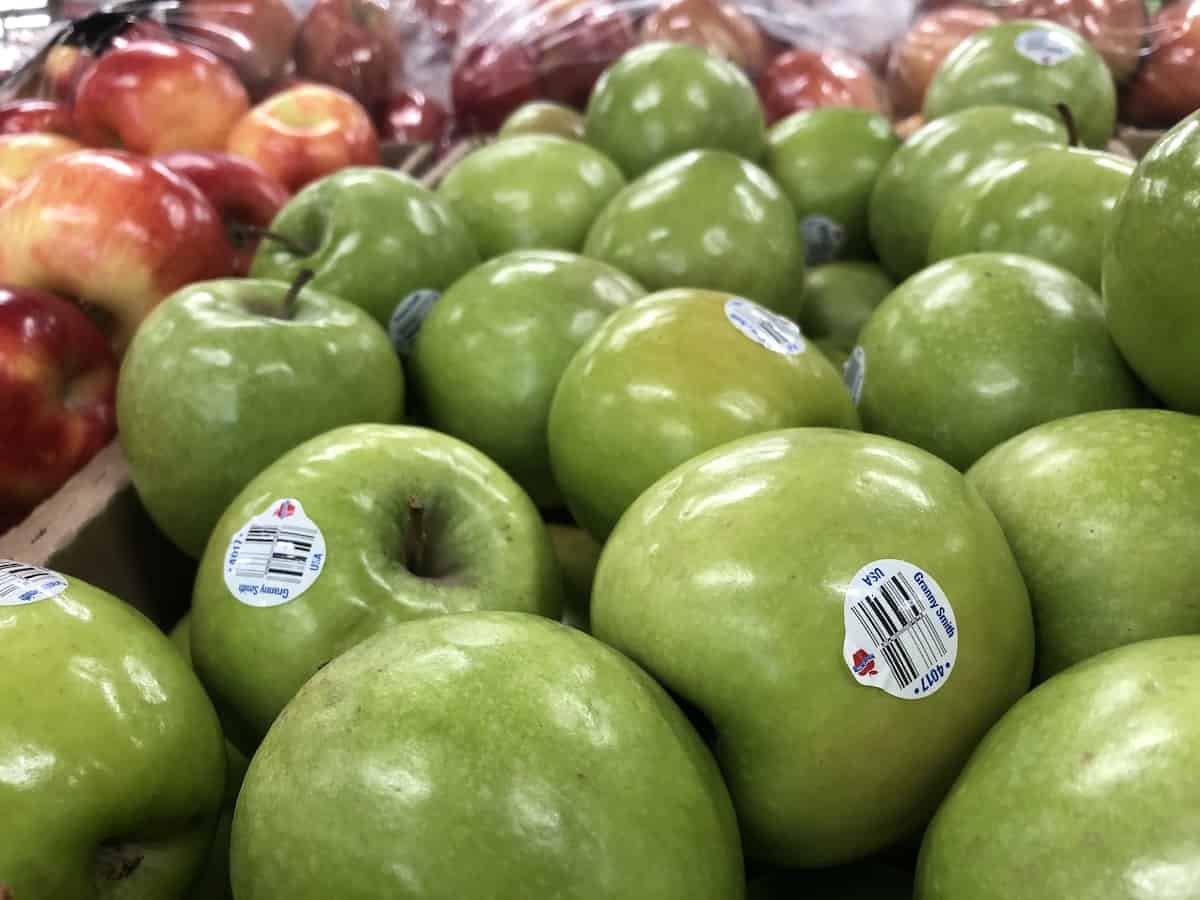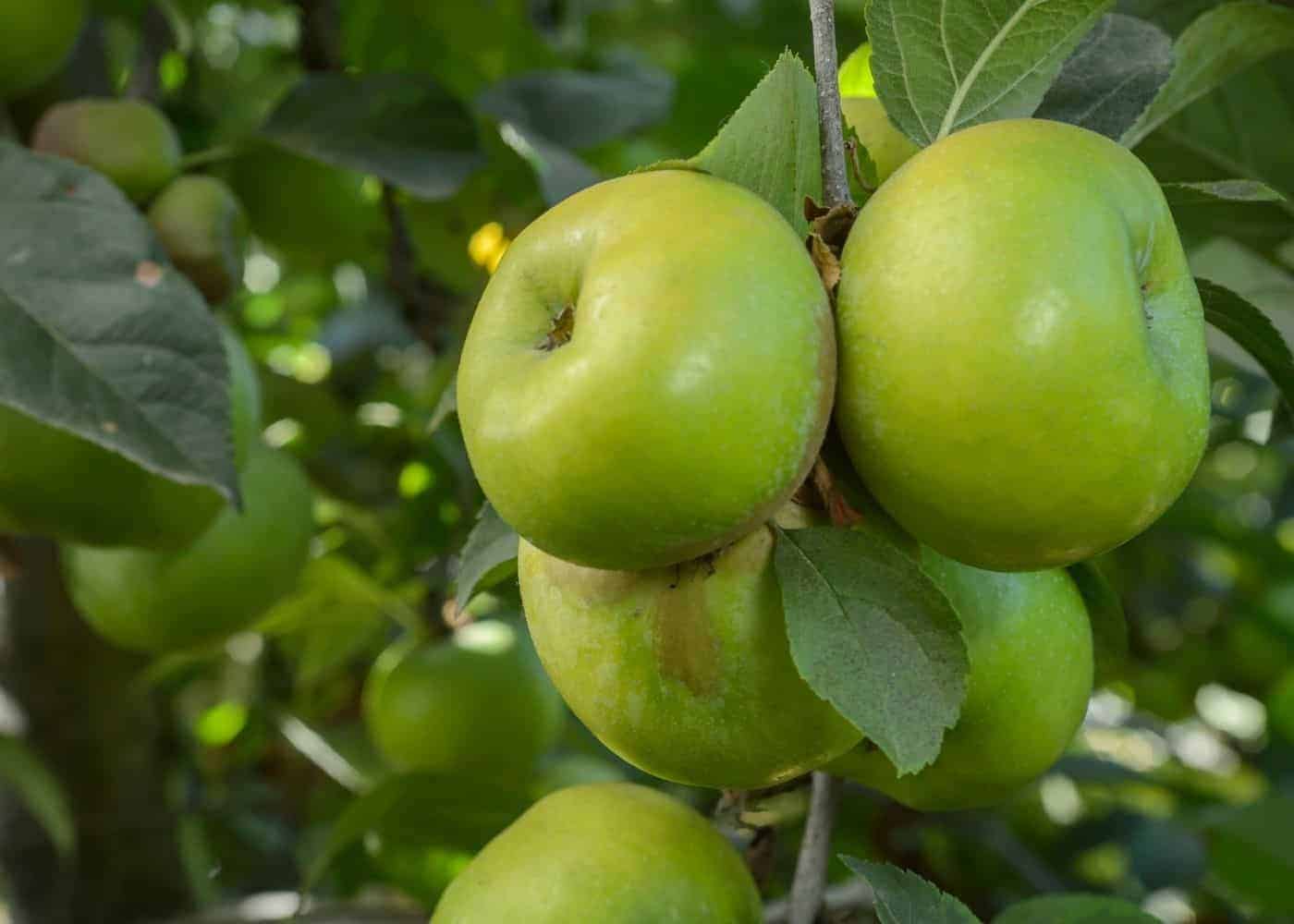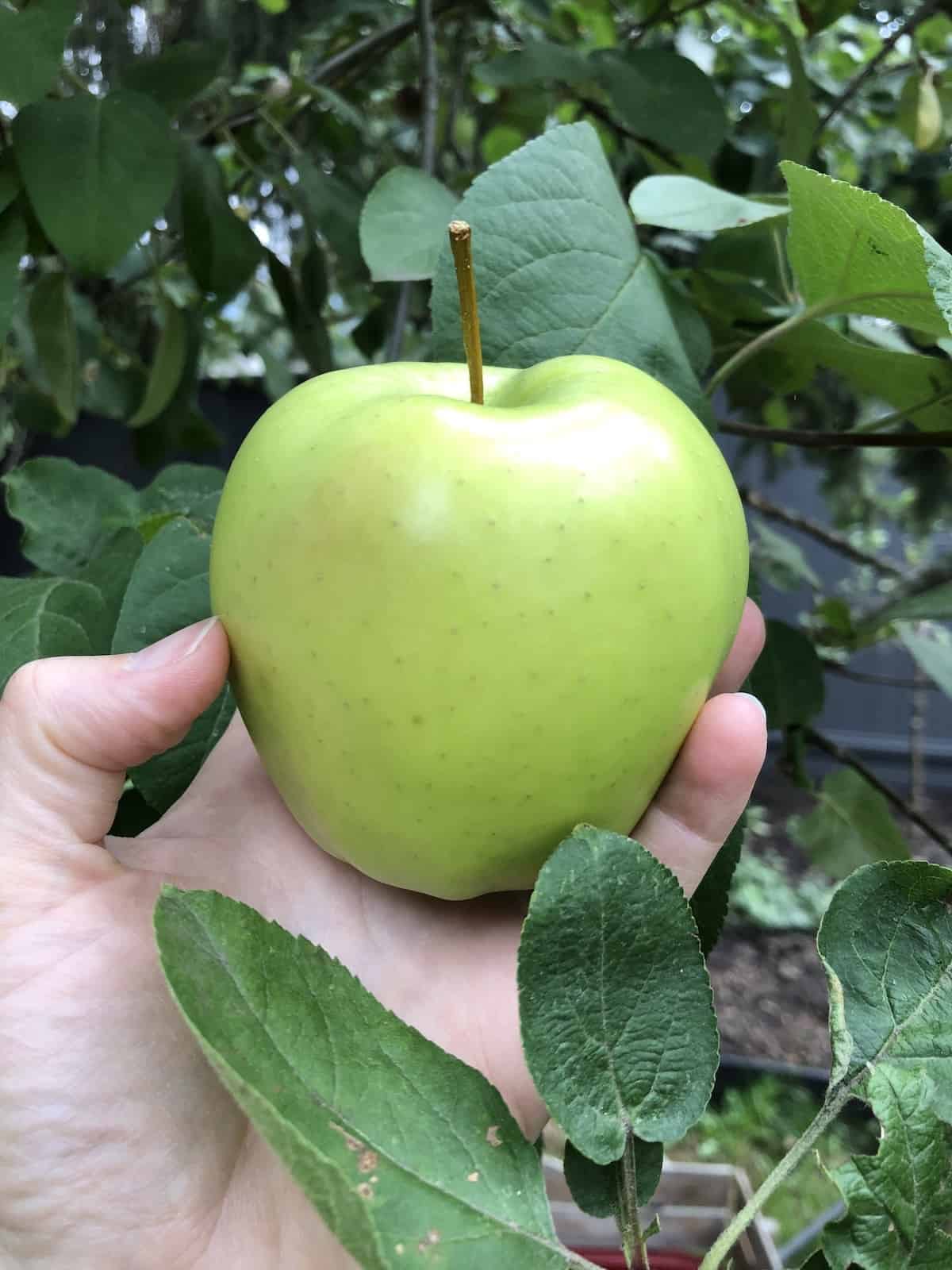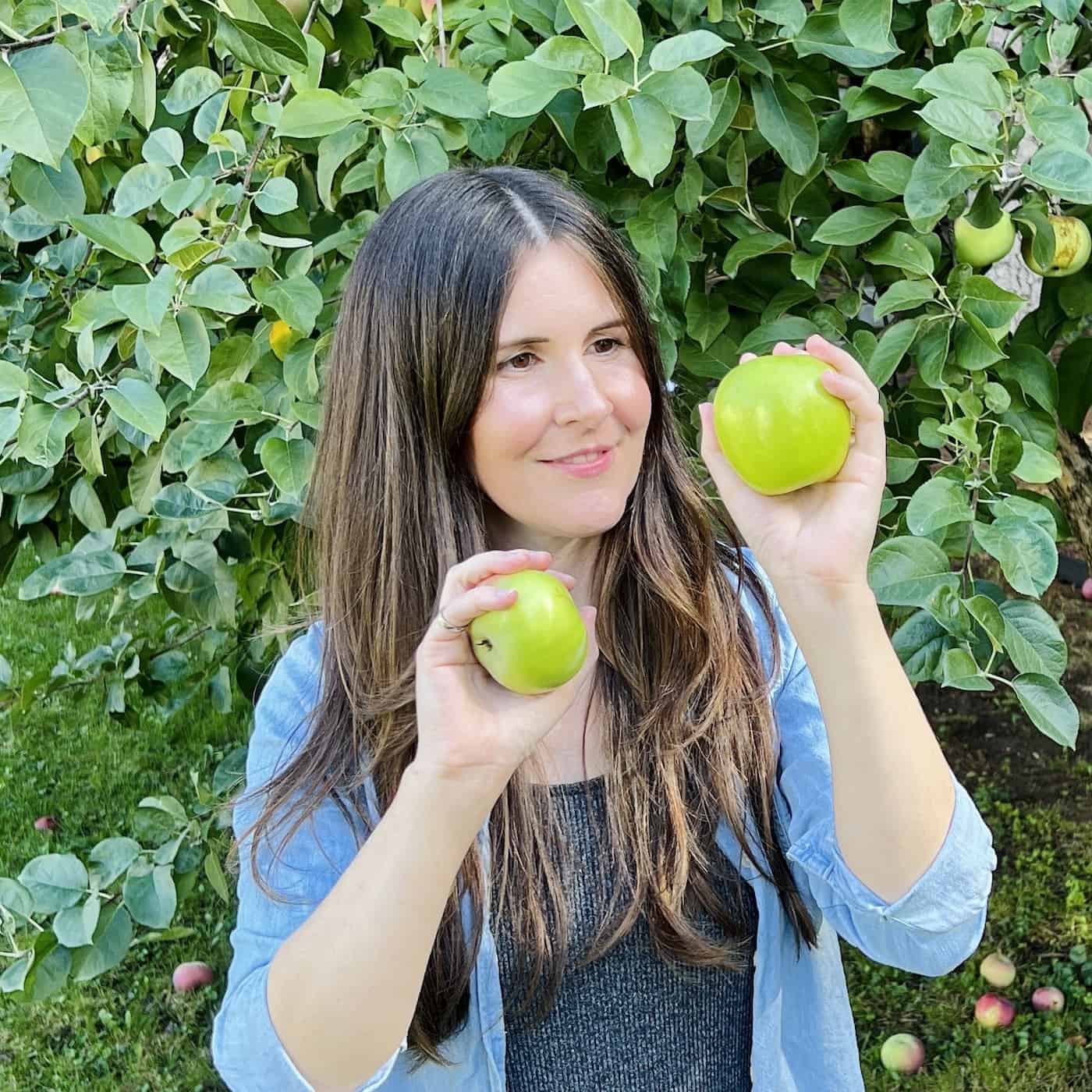Green apples are specific varieties that remain green when ripe. Green apple varieties include heirloom favorites like Granny Smith, Rhode Island Greening, and Newtown Pippin, as well as modern introductions such as Shamrock, Smeralda, and Crispin. The green peel (and lack of red coloration) is also affected by environmental factors like temperature and sunlight.

1. Granny Smith apple
The Granny Smith is the classic tart green apple variety. These sharp and juicy tart apples are beloved the world over, both for eating fresh and for use in baking like apple pies and crisps. They’re also one of the most popular types of apples for juicing, dipping, and appetizer trays. You can buy them in most supermarkets around the globe.
Granny Smith Apples have a true green-colored peel and light greenish-white flesh. These are large apples with a classic tart apple flavor. Granny Smith is known for its bold, acidic tartness, which could almost be described as sour.
Discovered in Australia, Granny Smith apple trees grow best in warmer regions with long growing seasons. Granny Smith apples are grown all over the US, including Washington, New York, Michigan, and California.
Warm temperatures, especially in the fall, tend to suppress an apple’s ability to create red pigment. Green Granny Smith apples grown in cool climates may develop a pink-red blush in years with cold fall nights and clear autumn days.
“Everything about Granny Smith is GREEN. The skin color. The flesh color. The flavor. Even the juice has a green tint.”
Apples Of Uncommon Character: 123 Heirlooms, Modern Classics, & Little-Known Wonders, by Rowan Jacobsen

2. Newtown Pippin apple
Newtown Pippin is a popular, all-American green apple from New York City. This apple has a smooth peel, often with a bit of gold russeting on it. The peel is a true green when freshly picked, but matures to a yellow as the apple becomes sweeter in storage. The peel tends to be more green in cool years and cool climates and more yellow in warmer conditions.
Newtown Pippin green apples can be found in specialty markets and orchards, but not usually in big box grocers. I live on the West Coast and it can be difficult to find these apples at all here (although not impossible – there are some pretty cool independent orchards around). Both the individual apples and the apple trees are generally more expensive than Granny Smith simply because Newtown Pippin trees are so much rarer.
The Newtown Pippin is most commonly used as a dessert apple for baking classic American apple pies and crisps. It has an incredibly rich flavor with lovely tart acidity. Sweeter, well-ripened fruit is sometimes eaten fresh, especially on cheese boards as a unique, American, heritage variety apple.
3. Rhode Island Greening apple
Rhode Island Greening is a firm, tart green apple. A true American heirloom variety, Rhode Island Greening apples have a vibrant tart flavor that can be almost citrusy. The yellow-green flesh is dense and can be quite juicy in good years.
Rhode Island Greening apples are mainly sold at specialty markets and orchards on the east coast of the US. They can be used in any recipe that calls for Granny Smith apples, including apple pie and tart green applesauce. Think of Rhode Island Greening as an old-school predecessor to Granny Smith from the United States (with perhaps a more complex flavor than Granny Smith).
4. Pound Sweet apple
Pound Sweet is a soft, sweet green apple. An heirloom from Connecticut, Pound Sweet apples are particularly large and have shiny bright green skin. These apples could easily be mistaken for a Granny Smith by appearance but have almost no tart acidity in their flavor.
Pound Sweet apples are available mainly around the East Coast of the US, where they’re most commonly used to make apple butter. This specialty apple is rarely found in commercial orchard operations but sometimes at local family-run orchards and farmer’s markets.
“Pigmentation in the skin of apple fruit varies among different cultivars and is influenced by environmental factors, including temperature conditions and the level of sunlight irradiation.”
Anthocyanin Biosynthesis in Apple Fruit, The Horticulture Journal 87(3), 2018, by Chikako Honda and Shigeki Moriya
5. Shamrock apple (tart, green apple)
Shamrock apples are crisp, tart, and green apples. Well-ripened fruits may have a small red blush patch, but most Shamrock apples have a true green peel. The flesh inside is a pale green color. These apples are great to eat fresh (for sour-apple lovers) or to use to make green applesauce. They feature white flesh that resists browning when sliced.
Harvested in mid-September, they are a doppelganger for Granny Smith, thanks to their low phenol content. If left to ripen until late September or early October, their color lightens, and their flavor more closely matches that of a high-quality McIntosh.
Shamrock apples were bred in British Columbia, Canada (my home!) by crossing the classic red-green McIntosh with the sweet and juicy Golden Delicious. This specialty variety has limited availability and doesn’t store well, so look for it at farmers’ markets from late September through to November.
It’s most unfortunate that Shamrock apples generally don’t store until St. Patrick’s Day! Perhaps Australia/New Zealand can supply North America one day.
6. Smeralda apple (Italian emerald apple)
Smeralda is a new sweet-tart green apple developed in Italy. Also known as the Italian Emerald apple (mostly by me, with my lack of Italian language skills), Smeralda is similar to Granny Smith but was bred to be sweeter, resistant to disease, and earlier to ripen in the fall. While current availability is limited, this new variety is poised to become one of the most popular green apples out there!
Smeralda apples were bred in the Northern region of Italy, close to Venice. They are named after the Costa Smeralda area on the Italian island of Sardinia, which translates to “Emerald Coast”.
“The fruit is medium-large with a smooth, uniform green color. The fine, crispy, juicy, pleasant flesh is yellow with an excellent flavour, feeling fresh in the mouth because of its high sugar content and elevated acidity. The taste is similar to ‘Granny Smith’ but sweeter and more fragrant.”
Apple tree named ‘Smeralda’, US Patent USPP24137P3 (Filed 2011)
7. Crispin (Mutsu) apple
Crispin (Mutsu) apples are sweet and crunchy, with a green-yellow color to their peel. In particularly crisp autumns, they can sometimes even have a small orange patch of blush. These apples are sweeter than many other green apples, but still retain that lovely, satisfying crunch in texture.
The green-yellow peel likely comes from one of its parent apples, the Golden Delicious. This green-yellow variety has a lovely sweet, honeyed, flavor that the Crispin shares. The Crispin/Mutsu is, however, more crisp and crunchy than Golden Delicious, and is a very satisfying fresh-eating apple.
8. Lodi apple
Lodi apples are tart apples with a pale green peel and soft ivory flesh. While there is a bit of sweetness to the flavor, Lodi apples are decidedly tart! The velvety smooth, fine, tender texture and sharp, acidic flavor make this an excellent apple for baking and for cooked applications like applesauce.
Lodi apples were bred in New York State using the Yellow Transparent variety, which helps to make them early to mature in the autumn. Lodi apples are often available 6-8 weeks before fresh, new-crop Granny Smiths. They’re a great pick for pies and applesauce, especially before the later-maturing green apple varieties are available.
9. Tolman Sweet apple
Tolman Sweet apples are medium-sized green heirloom apples with a truly sweet flavor. The flesh is crisp and dry but not tangy. These apples can turn a bit yellow in storage, so enjoy them when they’re fresh and green!
Discovered in Massachusetts several hundred years ago, this American heritage apple is only available from specialty orchards from late September to November. Tolman Sweet green apples are wonderful when eaten fresh, baked, or made into naturally sweet applesauce.

10. Aurora apple
Aurora apples are a sweet, golden-green specialty apple. Known by their full name, the “Aurora Golden Gala”, these pale green apples are among the best-tasting varieties for eating fresh, straight from the orchard. The Aurora Golden Gala is grown only in the Okanagan Valley (Canada) and Washington State, but it’s worth searching out!
Aurora apples are crispy yet sweet, with a complex but delicate flavor. A cross between the ever-popular Gala apple and the New Zealand favorite Splendour, they can be thought of as a golden-green colored Gala apple. The green-yellow color likely comes from its Splendour parent, which is thought to be descended from the Golden Delicious apple.
“Origin: ‘8S6923’ resulted from a cross between the seed parent ‘Splendour’ and the pollen parent ‘Gala’ made at the Pacific Agri-Food Research Centre (PARC), Summerland, BC by D. Lane and R. MacDonald in 1981.”
‘8S6923’ (Aurora Golden Gala) Apple, HortScience 40(1): 251-253. 2005.
11. Ashmead’s Kernel apple
Ashmead’s Kernel is an heirloom, tart green-golden russet-type apple from England. The peel ripens from pale green to almost a tarnished brass color. These apples are generally placed in storage for a month or two before being eaten to help them get a bit sweeter (they’re quite sour when first picked!).
Ashmead’s Kernel apples are most commonly used as a specialty heirloom for eating fresh or for making specialty apple juice and apple cider. Like some other russeted varieties, they have a citrus-like nutty flavor that’s worth searching out!
12. Duke Of Devonshire apple
Duke of Devonshire is a green-golden tart and fruity russeted apple. Possibly descended from Ashmead’s Kernel, this old British type is a favorite for apple juice and cider. Like Ashmead’s Kernel, the Duke of Devonshire benefits from a few months in storage before use. The flavor becomes sweeter and more complex (nutty, fruity) with storage.
13. Egremont Russet apple
Egremont Russet apples are English russeted apples with a green-gold-brown peel. Like other russet-type apples of its day, it tends to be juicy, nutty, crisp, and tart. Aged Egremont Russet apples tend to be a bit sweeter than Duke of Devonshire and Ashmead’s Kernel variety apples (but also still have quite a bit of tart acidity!).
14. Zabergau Reinette apple
Zabergau Reinette is an heirloom green-golden russeted apple from Germany. It looks almost like a round under-ripe potato but has a lovely, subtle sweet nutty flavor. While its sweetness is somewhat mild, Zabergau Reinette is among the sweetest russet-type apples.
15. Ananas Reinette apple
Ananas Reinette is a tart heirloom yellow-green apple from the Netherlands. While these apples have the classic green apple sour taste, they can sometimes have a truly tropical flavor when ripened on the tree. Properly ripened, these little green apples can taste like bananas, pineapples, and apples all rolled into one fruit.
16. Antonovka Green apple
Antonovka is an heirloom tart green apple developed in Russia over a hundred years ago. This sour green apple has a strong tart acidity, but also a nice fruity taste. Its crisp white flesh becomes sweeter in storage. Some fruits show some gold-bronze russeting around the stem, but others have yellow-green peels.
17. Shizuka apple
The Shizuka apple is a green apple from Japan that’s a sibling of the Mutsu/Crispin. Like the Mutsu, the Shizuka is a pale green-yellow color (likely from its Golden Delicious parent) with a lovely sweet taste and crisp texture. Some fruits have a slight orange blush or some russeting around the stem. Shizuku apples can be a little hard to find but can be just as lovely as their Crispin siblings.

18. Golden Delicious apple
Golden Delicious is a very sweet American heritage apple with a yellow-green peel. These apples are generally a pale green color at harvest time and mature to a golden yellow during winter storage. The Golden Delicious is an excellent all-around apple and is the parent apple to some of today’s sweetest modern apple varieties.
19. Ginger Gold apple
Ginger Gold apples are small yellow-green apples that tend to ripen quite early in the season. Ginger Gold was discovered in the US as a chance seedling and is likely a direct descendent of the Golden Delicious. Fortunately for sweet green apple lovers, the Ginger Gold apple is ready for harvest several weeks before the larger Golden Delicious fruits!
20. Grimes Golden apple
Grimes Golden is a sweet-crisp American heirloom apple variety from West Virginia. Great for eating fresh or for use in apple juices and apple cider, the Grimes Golden is a favorite of apple connoisseurs. It has a coarse but crisp texture with a sharp acidity offset with just the right amount of unexpected sugary sweetness. The Grimes Golden is thought to be a parent apple of the wildly popular Golden Delicious apple.
“Here’s an apple with an American pedigree: It was a chance seedling discovered in 1804 near a Brooke County, West Virginia, cider mill and orchard that had been established by Johnny Appleseed himself. The finder was Thomas Grimes, and he got to keep the naming rights.”
The Apple Lover’s Cookbook, by Amy Traverso
21. Golden Noble apple
Golden Noble is a tart English cooking apple used mainly for applesauce and British recipes that call for pureed apples. These apples are a light green color, turning yellow-green as they ripen. Golden Noble is a popular backyard apple variety in the UK.
22. Lyman’s Large Summer apple
Lyman’s Large Summer apple is a North American heirloom apple variety with smooth green skin. This green apple has a balanced sweet-tart flavor. As the name suggests, fruits ripen in late summer (and they are considerably larger than most summer apples).
“The creamy-white flesh is crisp and juicy with a balanced sweet-tart flavor.”
Apples of North America: Exceptional Varieties for Gardeners, Growers, and Cooks, by Tom Burford

23. Honeygold apple
Honeygold is a greenish-gold all-around apple developed by the University of Minnesota. It’s a bit like a green version of a Honeycrisp, although its taste is more like a Golden Delicious (one of its parents). These trees are very cold and hardy and the apples may develop a bit of a rosy-bronze blush in years with especially cool autumn nights.
24. Twenty Ounce Pippin apple
Twenty Ounce Pippin is a large green apple with a mildly tart flavor. This American heirloom is most commonly used for applesauce or for making dried apple chips. While not the strongest-tasting green apple, the Twenty Ounce Pippin is among the largest!
25. Calville Blanc d’Hiver apple
Calville Blanc d’Hiver is an heirloom French green apple used in classic French baking recipes. This heritage variety is pale green and generally a bit lumpy. Calville Blanc d’Hiver is a favorite cooking apple of French chefs and is gaining popularity as an apple pie apple in the US.
26. Green Pippin apple
The Green Pippin is a rare tart heirloom American apple variety. These medium-sized apples have a true deep green peel with some russeting (particularly around the stem). The juicy flesh is nicely acidic, making this variety wonderful for desserts like apple pie or tart apple butter.
27. Grenadier apple
Grenadier is a tart green English heritage cooking apple with tender flesh. The light green peel turns a green-yellow shade as the fruit ripens, and the inner flesh is also tinged with a light green hue. Grenadier apples are most commonly used in applesauce or pureed apple applications such as apple butter.
28. Manks Codlin apple
Manks Codlin is a tart, firm green cooking apple from the Isle of Man. These apples are bright green, and sometimes develop a few red blush patches when temperatures dip substantially in autumn. This hardy green apple has yellow-green flesh.
29. Pink Pearl apple
Pink Pearl is a sweet-tart apple with a dusty grey-green peel that camouflages truly vibrant pink flesh. This apple is the perfect surprise for those who like their apples a little bit differently. They’re a bit hard to find, but they’ll be the center of attention on your appetizer board!
30. Cole’s Quince apple
Cole’s Quince apple is a unique green apple variety with a quince-like flavor. Also called the Seneca Spice apple, this variety has coarse, crisp flesh that is wonderfully juicy. Cole’s Quince is a wonderful variety for a gourmet apple tart.







